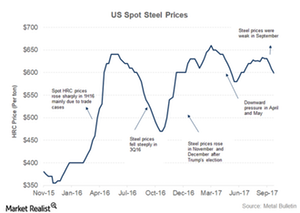Why the Outlook for US Steel Prices Is Bright beyond 4Q17
While US steel prices rose to a high of $660 per ton in March 2017, they fell to $580 per ton in June.
Nov. 20 2020, Updated 3:12 p.m. ET

Steel prices
Steel prices are the major driver of steelmakers’ earnings and revenues. So, it’s important for steel investors to track the trend in steel prices. In 2017, US steel prices have mostly been range-bound.
While prices rose to a high of $660 per ton in March, they fell to $580 per ton in June. In the second half of 2017, however, there has been slight weakness in these prices.
We also saw price hike announcements by several US steelmakers such as AK Steel (AKS). Investors should note that the last two rounds of price hikes have had a limited impact.
Impact on CLF
The deadline for the Section 232 probe into the US steel imports is ending in mid-January. Steelmakers are hopeful that the probe could result in lowering of imports, which have been impacting US steelmakers (SLX) negatively. Such a move would be positive news for steelmakers (NUE) (X) as well as Cleveland-Cliffs (CLF).
Investors might recall that Cleveland-Cliffs downgraded its volume guidance for 4Q17 during its 3Q17 results. This was mainly to reflect lower nominations from one of its customers, which was impacted by higher imports.
Outlook
In addition to the Section 232 probe results, steel demand could be another positive catalyst for steel prices in 1Q18. Steel demand usually picks up in the first quarter. Along with lower supply chain inventories, this could support US steel prices in 1Q18.
